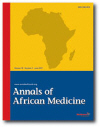
|
Annals of African Medicine
Annals of African Medicine Society
ISSN: 1596-3519
Vol. 6, No. 1, 2007, pp. 22-25
|
 Bioline Code: am07005
Bioline Code: am07005
Full paper language: English
Document type: Research Article
Document available free of charge
|
|
|
Annals of African Medicine, Vol. 6, No. 1, 2007, pp. 22-25
| en |
Experiences in Management of Pott's Paraplegia and Paraparesis in Medical Wards of Usmanu Danfodiyo University Teaching Hospital, Sokoto, Nigeria
Njoku, C. H.; Makusidi, M. A. & Ezunu, E. O.
Abstract
Background:
Pott's disease refers to spinal tuberculosis, which commonly leads to a gradual onset of
neurological deficit that are difficult to diagnose at the early stage.
Method:
The study was a combination of retrospective and prospective study. Information was
obtained using a predesigned protocol. Diagnosis was based on clinical features and plain spinal x-ray.
Anti-tuberculous therapy was instituted in all patients for a minimum of 18 months. Monitoring of
neurological status was done weekly.
Results:
There were 92 patients made up of 71 males (77.2%) and 21 females (22.8%) with a male:
female ratios of 3.4:1. 53.3% were paraplegic while 46.7% were paraparetic. The age group 31-40 years
was the most affected. 43.5% of the patients were farmers who formed the majority. Back pain, weight
loss, paraplegia and paraparesis in that order were the common clinical features. 25% of the patients
recovered full use of their lower limbs at the end of the study. Thoracic spine and lumbar spine were
equally involved (41.5% respectively) while thoraco-lumbar spine was involved in 15.1% of patients.
Cervical spine was only involved in 1.9% of the patients.
Conclusion:
Effective management of spinal tuberculosis should be a teamwork involving the physician,
orthopedic surgeon, neurosurgeon as well as the radiologist. The rural populace needs to be educated to
prevent late complications and ensure better prognosis.
Keywords
Pott's paraparesis, paraplegia, medical management
|
| |
| fr |
Njoku, C. H.; Makusidi, M. A. & Ezunu, E. O.
Résumé
Contexte:
La maladie Pott fait référence à tuberculose spinal qui mène généralement gà un début
progressif de déficit nuerologique qui sont difficile à diagnostiquer dans son étape de commencement.
Méthode:
L'étude était une combinaison retropective et prospective. Les informations sont obtenues en
utilisant un protocole préconçu. Le diagnostic est bassé sur les traits cliniques et une radiographie spinal
simple. La thérapie anti-tuberculose a été instituer chez tous les malades durant 18mois au minimum. Le
monitoring de l'état nuerologique été fait chaque semaine.
Resultats:
Il y avait 92 malades compris de 71 hommes (72.2%) et 21 femmes (22.8%) avec la
proportion hommes : femmes de 3.4 :1. 53.3% sont paraplégiqques alors que 46.7% sont paraparétiques.
La tranche d' âge de 31-40 ans sont les plus affectés. 43.3% des malades sont des fermier qui font la
majorité. Les maux aux reins, la maigreur, la paraplégie et la paraparésie, dans cette ordre sont les traits
medicales commun. 25% des malades ont recouvré l'usage complet de leurs membres bas à la fin de
l'étude. L'epine thoraçique et l'epine de dos inférieurs sont également inclus (respectivement 41.5%)
tandis que l'epine thoraco de dos inférieurs sont inclus en 15.1% malades. L'epine cervicale était
seulement inclus en 1.9% de malades.
Conclusion:
La gestion efficace de la tuberculose spinal doit être une collaboration entre le médecine, le
chirurgien orthopédiste, le neurohirurgien, aussi que le radiologue. Les paysans doivent être instruit pour
empêcher les complication tardive et assurer un bon pronostic.
Mots Clés
Le paraparésie, le paraplégie, la gestion medicale
|
| |
© Copyright 2007 - Annals of African Medicine
Alternative site location: http://www.annalsafrmed.org
|
|
